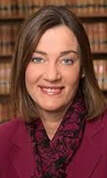 Nashold Nashold By Gretchen Schuldt A judge was correct in ordering a man to pay potentially tens of thousands of dollars in court surcharges for having child pornography images that were never included in criminal charges against him, the State Court of Appeals has ruled. The District IV Court of Appeals panel, however, sent the case back to circuit court to determine whether all of the pictures involved were actually associated with the crime for which William C. MacDonald was convicted. MacDonald pleaded guilty in Marquette County Circuit Court to one count of possessing child pornography. As part of the plea bargain, another nine counts, each based on an individual picture, were dismissed but read into the record. Read-in charges, Appellate Judge Jennifer E. Nashold wrote for the three-judge panel, are agreed to by both the prosecution and defense. A judge can consider the read-in charges when imposing sentence, though they do not increase the maximum sentence the defendant faces. A judge can also order a defendant to make restitution for read-in charges. Finally, prosecutors cannot later bring formal charges for counts read in. MacDonald's plea agreement said that "the State would be moving to dismiss and read in the rest of the charges...in addition to any uncharged image that was part of this investigation, so that the State will not be filing any additional charges for any other images, but we would be asking that they be read in as part of the sentencing in this matter." Circuit Judge Bernard N. Bult sentenced MacDonald to four years in prison and three years of extended supervision. He also levied mandatory $500 surcharges for the photo that was the basis of the charge, nine photos for the counts that were read in at sentencing, and 90 additional images that did not serve as the basis for a charge. The total in surcharges was $50,000 for 100 images. MacDonald, arguing that the surcharge should be limited to $500 for the one count on which he was convicted, requested in a post-trial motion that the surcharge be reduced, but another circuit judge, Mark T. Slate, refused. MacDonald appealed, but the appeal was put on hold while the state Supreme Court considered another case involving the child pornography surcharge. In that case, State v. Schmidt, the court ruled that the surcharge did apply to pictures included in read-in counts. MacDonald conceded the surcharge applied to the nine read-in counts, but continued to argue that the surcharge should not apply to counts that were not ever charged. The appeals panel disagreed. "We conclude that Schmidt does not directly answer this question but that, consistent with its analysis, the surcharge applies to read-in images regardless of whether there is an accompanying charge, so long as those images are 'associated with the crime,' ” Nashold wrote. State law, she said, does not limit read-in crimes to only those that were charged and dismissed. Nashold was joined in the opinion by Appellate Judges Brian W. Blanchard and Michael R. Fitzpatrick. In sentencing MacDonald, she said, Bult correctly noted that MacDonald's ability to pay the surcharge was not a factor. Bult imposed the surcharge on 100 images, though he believed there could be more pictures involved. "Read-ins may be considered for restitution and sentencing purposes regardless of whether they are uncharged or charged and dismissed. Thus, we discern no basis in the statutes or case law for a sentencing court to treat uncharged and read-in images differently from charged and read-in images for purposes of applying the surcharge," Nashold wrote. The panel, however, remanded the case back to circuit court for a judge to determine whether the images that formed the basis of the surcharges actually were "associated" with the crime for which MacDonald was convicted. State statute requires a judge to determine the "association" by a preponderance of evidence – a lower standard than that required for conviction – and without a jury. "Here, it does not appear that the sentencing court engaged in any fact-finding to determine the association, if any, between the 90 uncharged images and the image forming the basis of the count of conviction," Nashold wrote.
0 Comments
Your comment will be posted after it is approved.
Leave a Reply. |
Donate
Help WJI advocate for justice in Wisconsin
|
Copyright © 2024 Wisconsin Justice Initiative Inc.
The Wisconsin Justice Initiative Inc. does not endorse candidates for political office. The Wisconsin Justice Initiative Inc. is a 501(c)3 organization.
The Wisconsin Justice Initiative Inc. does not endorse candidates for political office. The Wisconsin Justice Initiative Inc. is a 501(c)3 organization.

 RSS Feed
RSS Feed